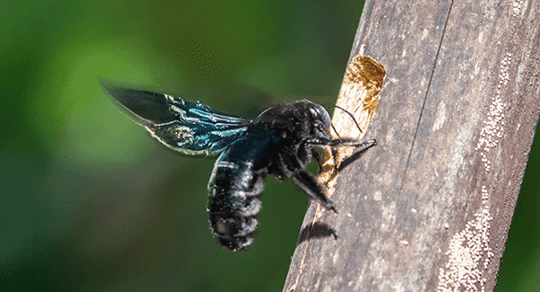You see a bee and you immediately go into panic mode thinking you are going to be stung. You may grab a fly swatter or a can of bee and wasp spray and go to town trying to kill them off. While bees can sting, and that bee spray might work to eliminate them, it’s best to slow down and stay calm rather than running around swatting at it. Most bees will leave you alone if you leave them alone, including carpenter bees.
Carpenter bees are relatively harmless to people as they are a more solitary species of bee, meaning they don’t live in a hive with other bees, and don’t swarm or attack. They can often be confused with other bees like honey bees and bumble bees as they are similar in appearance. The one thing that sets them apart is that they have shiny black abdomens with no hair, unlike their look-alikes.
Male carpenter bees can be aggressive and will protect their female and their eggs and larvae by buzzing right up in your face. However, this is just a scare tactic as the males cannot sting. Females can sting but are much less aggressive and will only do so if threatened or when you come into direct contact with them.
The biggest problem with carpenter bees is that they can cause damage to the wood of your home by building their nests. Carpenter bees tunnel into untreated softwood. And when they do, they leave round, smooth holes where they have burrowed. In those holes, the carpenter bees will lay their eggs and tend to their larvae.
Carpenter bees can hibernate and will overwinter inside these holes. When they emerge in the spring, they will begin to create new holes, causing more damage to your home. Year after year, these wood-destroying bees can cause damage to your porches, decks, siding, foundation, and wherever else they choose to create their nests. While carpenter bees don’t eat the wood like termites or continuously tunnel like carpenter ants, they can still do a great amount of damage with the number of holes they can create.
A great way to prevent carpenter bees from choosing your property for their nesting sites is to protect your wood. Painting or staining any trim, decks, sheds, and porches can help keep carpenter bees away. Choosing hardwoods for construction instead of softwood is also a key step in avoiding future carpenter bee damage.
While grabbing that can of bee spray or fly swatter may seem like the best solution to get rid of carpenter bees, that often isn't the case. You should take caution when dealing with stinging insect infestations because, if you are mistaken about the type of bee you are dealing with, you could do a lot of damage. One, you might get stung and have an allergic reaction, and two, you may misidentify the type of bee you are dealing with and accidentally kill off protected and beneficial honey bees, causing harm to the surrounding ecosystem!
Enlisting the help of the professionals at Big Blue Bug Solutions is the best solution when dealing with stinging insect problems! Our pest control experts will properly identify the type of bee you are dealing with and will perform the appropriate treatment. We also offer year-round pest control plans that cover carpenter bees so that you won’t have to deal with an infestation again! Contact us at Big Blue Bug Solutions for more information.

